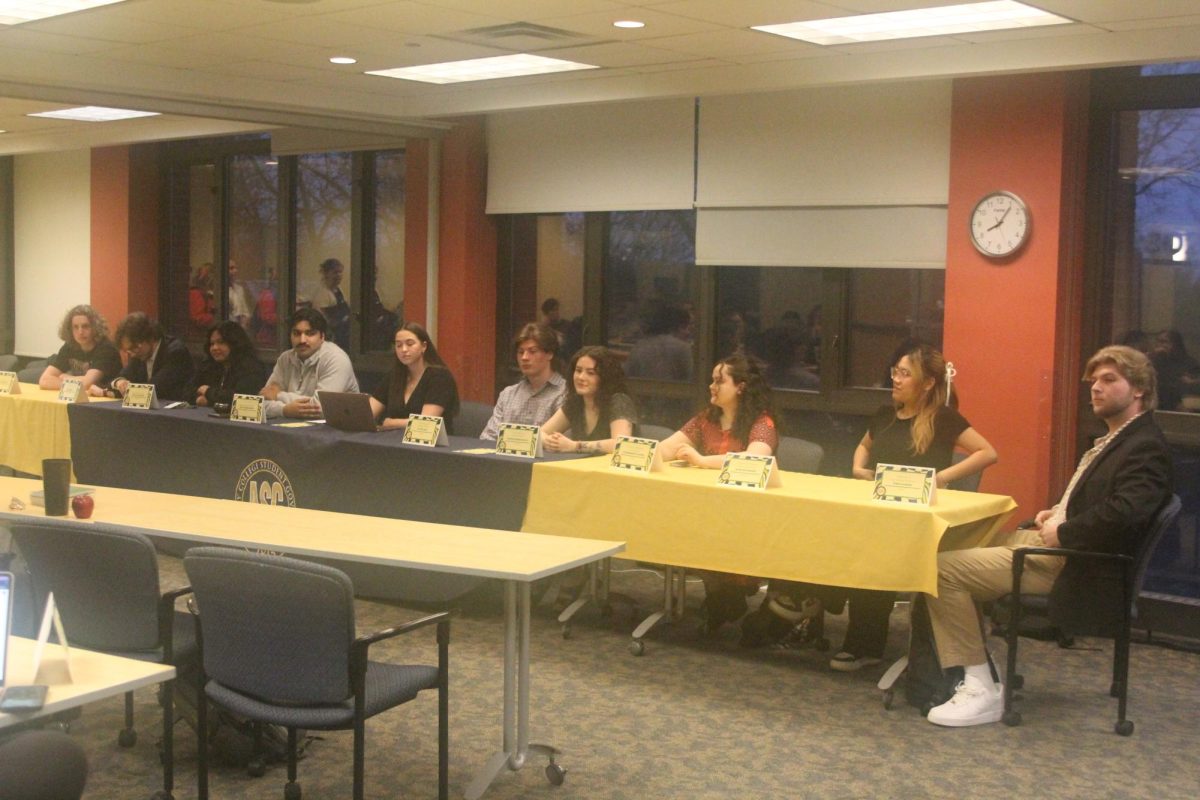The results are in. The Allegheny College Climate Assessment Project, a campus-wide survey that was conducted to evaluate student, staff and faculty perceptions of conditions at Allegheny, has been completed and its findings have been released.
The survey, organized by Rankin & Associates (R&A) in 2009, consisted of 109 qualitative and quantitative questions to measure the opinions of Allegheny’s community members on topics ranging from overall satisfaction with Allegheny to diversity issues on campus.
Full details of the results will be contained in a 210-page Report that is currently under revision and will be available to read in June. However, a more manageable 15-page Executive Summary of the Report has been released. Professor Susan Rankin of R&A of Penn State also came to campus Tuesday and Wednesday to present highlights from the survey.
“The student response rate was one of the highest we’ve had in the work that I’ve done,” Rankin said during her presentation Tuesday.
According to the Executive Summary, the 1,171 surveys that were completed (a 55 percent response rate) represented 834 (71 percent) students, 141 (12 percent) faculty members and 185 (16 percent) staff members.
Of those who responded, 90 percent of students reported being “highly satisfied” or “satisfied” with their education at Allegheny and 82 percent of Allegheny College employees were “highly satisfied” or “satisfied” with their jobs.
Sarah Szymecki, ’11, agreed with these results. “I feel like I’m getting a good education, one that I’d feel proud to put on a resume; I’m happy,” she said.
Associate Dean and Professor of English Benjamin Slote was pleased with the reported levels of high student satisfaction.
“If there’s any most important statistic for the health of the institution that’s the first one,” Slote said. “And Professor Rankin underscored that she never sees a number like that. She’s done it at eighty plus schools, so that’s very good news.”
Rankin pointed out that whether or not Allegheny has high educational standards, students perceive that they are getting quality instruction.
“Whatever’s happening here with education, you’re doing a good job,” Rankin said. “Or at least you think they are.”
Katie Donahoe, ’10, agreed.
“I’m a second-semester senior, so I’d like to think I’m satisfied at this point,” she said. Donahoe also added, however, that she wished she had received more guidance and advice from her professors.
The report indicated that people were generally at ease on campus. Most respondents marked that they were “comfortable” or “very comfortable” with the overall climate at Allegheny (82 percent), in their department or work units (77 percent) and in their classes (86 percent), according to the Executive Summary.
“Overall, people are pretty happy here,” Rankin said. “But what’s more important for me is who’s not happy.”
The figures noted some disparities between levels of satisfaction at Allegheny based on race and sexual orientation.
“A lot of feedback from the survey suggests that we have some progress to make in terms of making this a welcoming environment for those [minority] students,” Slote said.
In comparison with the 83 percent of White people who reported being “very comfortable” or “comfortable” with the overall campus climate, only 65 percent of People of Color reported the same level of satisfaction. Similarly, compared with 83 percent of heterosexual people, 78 percent of lesbian, gay, bisexual and queer (LGBQ) people were comfortable with the campus’s climate.
Students of Color, which is the phrase used in the summary, and LGBQ students also reported being less satisfied with their education at Allegheny. Additionally, 21 percent of all employees reported observing discriminatory hiring, and 18 percent observed unfair, unjust, or discriminatory employment-related actions.
Some students think that Allegheny’s shortcomings stem from a lack of student interest in diversity issues.
“There’s a division of people on campus between people who seem to really care and those who are more apathetic,” said Becky Wertz, ’11. “It’s sort of a matter of opening it [the issue] up to people who don’t see it as relevant to them.”
Bryan Sciulli, ’11, agreed.
“Student interest is a problem here,” he said. “When push comes to shove, there’s very little interest.”
Donahoe said that student groups that dealt with diversity issues, namely LGBTQ groups, experienced setbacks in raising awareness because of time and budget constraints as well as a lack of student commitment.
Race and gender also appeared as themes in the results for the presence of harassment on campus. According to the report, a total of 15 percent of respondents said they had personally experienced offensive, hostile, exclusionary, or intimidating conduct that interfered unreasonably with their ability to work or learn. This conduct was based on gender (26 percent), position at the college (21 percent), age (16 percent), and religious/spiritual status (16 percent).
Of Respondents of Color who reported harassment, 43 percent stated it was because of their race. Thirty-five percent of the women who experienced this conduct stated it was because of their gender and 54 percent of LGBQ respondents stated it was because of their sexual orientation.
Women were three times more likely than men to experience sexual harassment and twice as likely as men to experience sexual assault, according to the Summary.
Rankin stressed that although women were more likely to be victims of sexual assault and harassment, men also faced these abuses. The report showed that 20 people reported being sexually assaulted in the past year.
“I think it’s important to know that it’s not gender one-way,” she said.
Rankin also noted that Allegheny’s population represents more nationalities and religions than it currently recognizes. According to Rankin, students who listed their religion as being “other,” reported practicing a wide variety of faiths. Although, she added jokingly, several of them reported being “Jedi.”
Sciulli agreed that there are many students on campus, such as those with other political views, who go largely unrecognized.
Another problem at Allegheny indicated by the statistics is the inaccessibility of the campus to those who are disabled. Twenty-two percent of respondents believed college housing and 20 percent of respondents believed classroom buildings to be “very inaccessible.”
“I think the extent to which the campus is inaccessible to people with disabilities is a clear and obvious area where we need to improve and I’m confident we will improve,” Slote said. “I hope we do it fairly quickly.”
“Overall,” states the Executive Summary, “the results in this report parallel similar investigations where People of Color, women, sexual minorities, and people with disabilities tend to feel that the institution is not addressing systemic, structural, and informational issues as favorably as for their White, male, heterosexual, and able-bodied respondents.”
Hearing all these results left some audience members at Tuesday’s presentation wondering how Allegheny stacked up to other colleges. When asked this question, however, Rankin refused to comment, saying that Allegheny was too unique a college to judge it against others.
“For me,” she said, “to compare you is like comparing apples and oranges.” Rankin explained that Allegheny had to focus on its personal improvement.
Slote agreed.
“It matters less how we compare with some national average,” he said. “I still think that there’s room to improve.”
According to the Summary, “The next steps in this project are to use the results of this assessment to identify specific strategies for addressing the challenges facing the community and to support positive initiatives on campus.” The full Climate Survey Report, to be released in June, will provide complete coverage of many more topics investigated through this study.







Ian Binnington • Apr 26, 2010 at 9:04 pm
You can read the Executive Summary at http://webmedia.allegheny.edu/pdf/AlleghenyClimateReportExecutiveSummary.pdf
frustrated • Apr 25, 2010 at 11:53 pm
Hey, WHERE IS THE 15-page EXECUTIVE SUMMARY??!?!?!?
I have been trying very hard to find this, I don’t see a link anywhere!
Nikki M • Apr 21, 2010 at 11:04 pm
I hope many large steps are taken to address the issues facing students who are not white male heterosexual able-bodied persons. I also hope more steps are taken to raise awareness about sexual assault and harassment. These issues are probably more serious than a lot of people would like to believe. It also pains me to see that many people have experienced discrimination in hiring. I would like to see the statistics for the tenure process, that would be interesting.